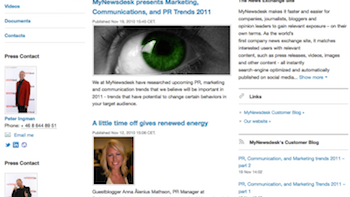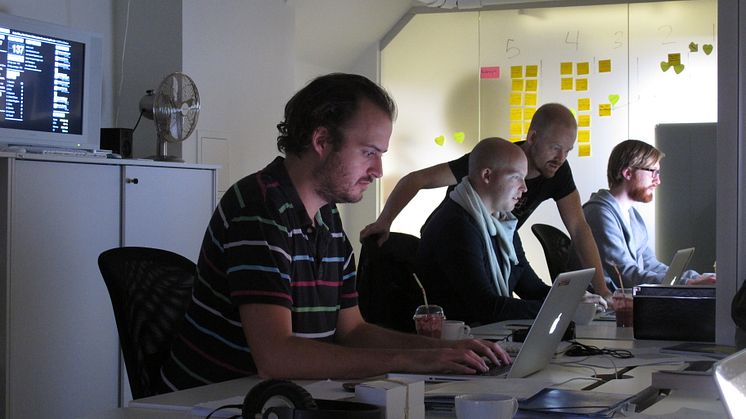
Blog post -
Social Media Newsroom – A Snapshot of Your Brand
5 ways to take your online newsroom to the next level
Journalists Expect an Online Newsroom
Journalists, customers, and other influencers use your website and online pressroom to find information about your company. More than any other part of your website, your online newsroom should be a snapshot of your brand. It should show exactly where you are, what you are doing, and how you are doing at the present moment. This is the information that journalists crave.
As journalists continue to use the web to do parts of their research, they have come to expect certain features from a company’s online newsroom. For example, it should present a clear and concise idea of what the company does, how it started, and where it is based. It should prominently display the latest news and events, as well as state the various ways a visitor can contact a person or department within the company.
Then there is the matter of all press material – material that not just the press are interested in, but also bloggers, influencers, and customers. Are you selling a product? All high-resolution images should be available for download. Have you sent out many press releases in the past? They should be available and archived in one easily accessible location. Moreover, all this press material should be searchable and useable.
But in the vibrant and dynamic social media landscape, where attention spans are ever decreasing, how can you make your online newsroom even more attractive and useful for the interested visitor? How can you take your online newsroom to the next level and create a Social Media Newsroom?
1. There Is No Social Media Newsroom Without Social Media
Whether it’s starting a company blog, opening a Twitter account, or creating a Facebook Page, more and more companies have started to share their messages and contribute to conversations in a fast-moving and highly transparent playing field. By doing a quick search for your favorite brand on media such as Flickr or YouTube, you can see that not only have companies opened official channels, but the employees themselves have uploaded content, sharing awareness on a grassroots level.
In other words, if you have taken the Social Media plunge, then you may know how effective it can be to engage your influencers. But you may also how difficult it can be to manage the different accounts. Although these social media accounts are free, they require a substantial investment of time. You must first get into the mindset that it is time-consuming. It can also be complicated to direct visitors from one channel or network to the other, depending on what digital media you want them to experience.
But what if a visitor to your online newsroom could get a quick overview of all the social networks you participate in? At a glance, your targeted audience could see what is being said about you on Twitter, which videos you are featuring on YouTube, or what your latest blog entries are about. Visitors can see that you have a Facebook Page or a Twitter account and might be encouraged them to “like” or “follow” you in those networks. Essentially, your social media newsroom can be the central point for all conversations on the different media with your known or unknown influencers
2. Remember What Your Mother Said: Sharing Is Caring
The basic idea behind an online newsroom is to make it easier for any interested visitors to take your press material and share it with their own audience. And in the new digital age, this requires more than just linking to material from an article. It entails providing the visitor with a means to share each press release, blog entry, newsflash, image, video, or online business card through the many different social networks.
A so-called Share Button is essential. Attached to all press material and relevant pages in your newsroom, it can be used to connect a visitor to their Twitter, Facebook, or WordPress accounts for example. It will then allow these users to share this material with their fellow followers.
Moreover, from a time perspective, an online newsroom should make it possible for you to upload any material published on your newsroom instantly to your social networks. If you have new high-resolution images or videos published, they should be uploaded to your Flickr or YouTube accounts in the same process.
3. A Picture Is Worth a Thousand Words… a Video Around Ten Thousand
The best way to add flair to your newsroom or your news releases is to publish catchy images and related videos – transforming your regular press release into a multimedia news release.
Are you releasing a new product? Any high-resolution images should be downloadable from your newsroom, while a lower resolution version should be embedded in your press release. Is there a great new service that you want the world to know about? Upload a high-definition video on YouTube and in your newsroom showing that service in action and embed that same video in the press release.
Images and videos are an essential part of your PR and marketing activities, and so-called multimedia news releases. Not only can they convey your message clearly and concisely, they are easily shared through social media. So, make sure your pictures and images are good enough that others will want to show them off.
Keep in mind though, that all images and videos must be published with the permission of the photographer. In other words, make sure you are not breaking any copyrights.
4. Barbarians At the Gate? Let Them In!
An issue companies deal with when jumping on the Social Media wagon is the sudden onset of negative comments – at least what appears to be a sudden onset. In reality these criticisms already exist, but the company had not seen them in such an open medium before. And that’s the key. Social Media opens your company up to a flood of opinions from your customers, intended for a wider audience to see and interact with. This audience could be other customers that will either concur or disagree, but this could also be potential clients, partners, or future employees.
And so, what do you do? Even if you are not on Twitter or Facebook, you can be sure someone is talking about you. The answer is to open up and not be vulnerable. Add comment fields to press material and let people comment freely and transparently (save for any potential spam comments). Your online newsroom should be a place where customers and influencers can voice their opinions for others to hear. If they are positive, then you will have the best publicity possible. If they are negative, then you have the opportunity to show how well you handle negativity in public. This can increase your value in the eyes of potential customers as much as positive remarks from their peers.
Essentially, the best brand ambassador you can get is a disappointed customer that you have turned into a happy one.
5. What You See Is What You Get: Your Employees Give Your Company a Face
The traditional pressroom tends to feature just one or two contact persons a journalist can reach for questions or comments on a story. It is quite common for companies to appoint a select few employees, like the PR Manager and the CEO, to be responsible for all press contact. They become the face of the brand towards this audience. They stick to a certain script and look. Everything is very controlled, but not very natural and not very “human”.
Journalists want to talk to the source of a story, which may not necessarily be the PR Manager. If a new product were launched, perhaps the designer would be a good person to contact in addition to the CEO. Moreover, profiling the employees that work in your company gives your company a human face. This affects your brand, which isn’t just a logo and a product. Your brand consists of the people that choose to work with it. In today’s social media landscape, it is essential for a brand or a company to show this human side.
Therefore, it is vital that your newsroom allows you to feature online business cards of all your employees (or at least those that will at some point have contact with customers, vendors, partners, or suppliers). These pages should feature pictures, job description, telephone numbers, email addresses, Twitter accounts, LinkedIn profiles, and anything else the potential visitor could be interested in. Furthermore, each business card should clearly state what subjects, questions, or business areas that particular employee could help with – saving time for journalists and other influencers looking for information.
The Social Media Newsroom Is Born.
The increasing popularity of Social Media has blurred the lines between the message and the messenger, the content and the content provider. Because of the immediacy, transparency, and “shareability” that Social Media provides, the person sharing a message is as important as the message itself. The network to which that person belongs also becomes a focal point.
Therefore, a social media newsroom is not just a glorified pressroom. It’s a snapshot of your brand. It tells the visitor quickly who you are, where you are heading, and who will be there cheering you on.
Jonathan Bean on MyNewsdesk's Social Media Newsrooms

